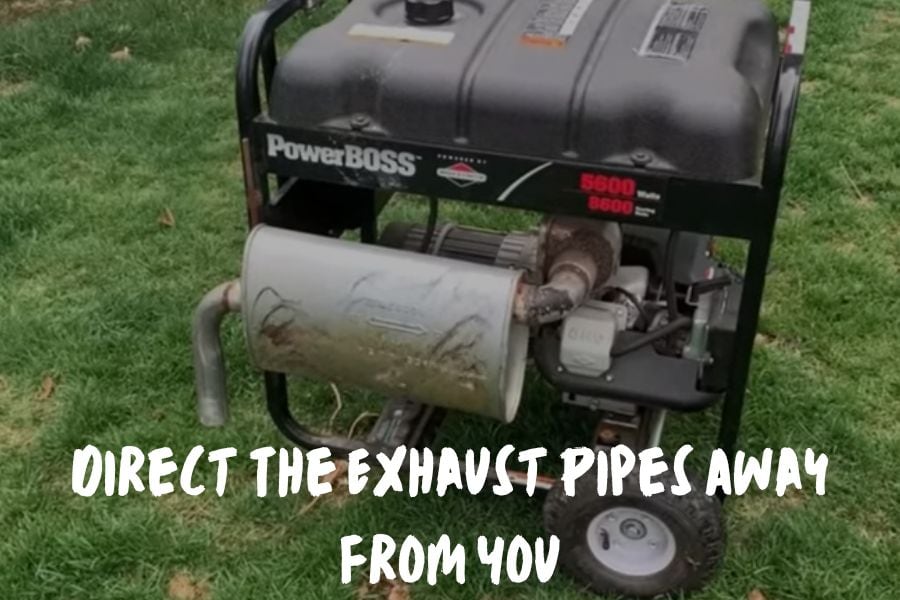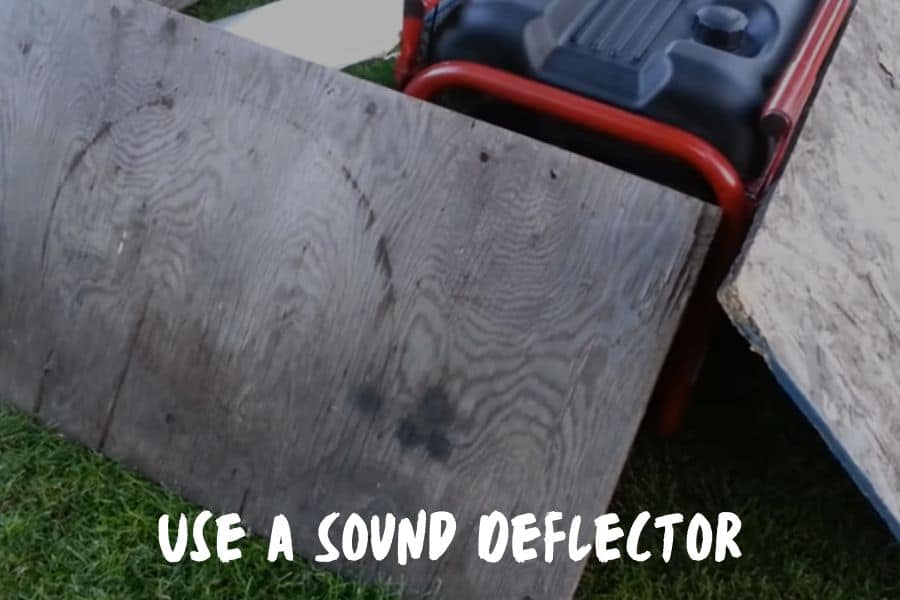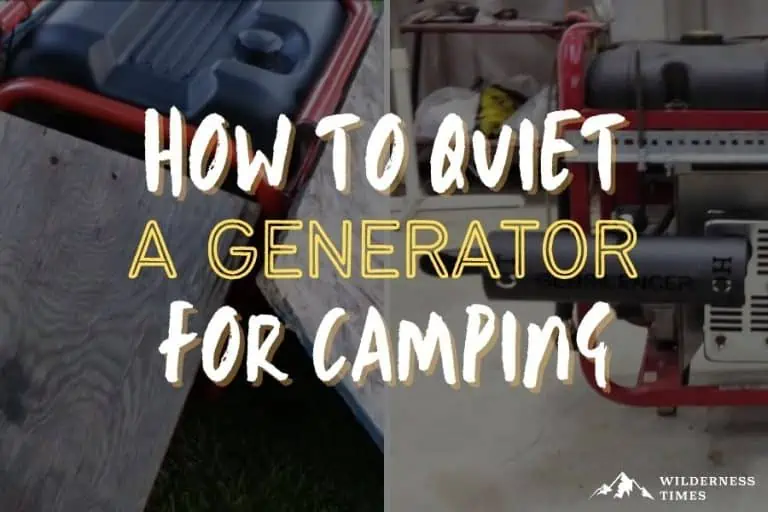A nature getaway while enjoying the comforts of home?
With a portable generator, everything’s possible. You can use a tent air conditioner, plug in your laptop, charge your phone, lighten up your campsite…
If only these things weren’t so loud.
But you don’t have to keep your fingers in your ears the whole time. In this article, I’ll show you how to quiet a generator for camping in several simple yet effective ways.
So let’s jump straight in!
Table of Contents
Toggle5 Tips For Making Your Generator Quieter
Until technology finds a way to make generators silent, we have to be creative when trying to lower the noise level.
Here are some ways you can do that:
Direct The Exhaust Pipes Away From You

As you know, sound travels linearly. So, whichever direction you point the exhaust pipes in, the sound will follow.
You can direct the pipes to go vertically, and the sound waves will go up into the air, and not towards you.
If, for whatever reason, you can’t direct the exhaust pipes towards the sky, just point them away from you.
Upgrade Your Muffler

After the engine itself, the exhaust pipe is the thing that makes the most loud noise. A generator muffler, as the name suggests, is supposed to muffle the exhaust noise.
Thanks to the perforated tubes inside a muffler, sound waves coming from the engine get deflected, which in turn lowers the amount of noise coming out.
So, one of your options for quieting a camping generator is going for a big muffler. You can even use a car or motorcycle muffler. With it, you can lower the generator noise for up to 12 decibels, so this method is worth trying out.
But, since there are many models of generators out there, finding one that fits can be difficult. You’ll probably have to get an adapter to change the size of the exhaust.
Finding a suitable adapter can also be a tough task. Another option would be using clamps and exhaust flex tubing to bolt the muffler on. While this method works to an extent, it’s not as soundproofing as using a muffler with the correct piping.
Another option would be to try and find a specialized mechanic or small engines repairman that would customize a muffler for you. Not everyone will do it, but this option is also worth considering.
If you’re out of luck finding the right muffler or adaptor for your generator, don’t worry. There are other ways you can make it quieter.
Which brings us to the next point.
Use A Sound Deflector

This method doesn’t make the generator quieter by magic, although it sure seems like it. What a deflector actually does is it diverts some noise away from you and into the earth.
You only need a few flat pieces of wood to make a barrier, and more often than not, you can find these laying around. But, if you’re trying to make the best sound deflector possible, here’s what you need:
- 4 sheets of plywood
- 1 sheet of drywall or another fire-resistant material
Each piece should be around 4×3 feet.
Making a sound deflector doesn’t get any easier than this. You just need to take those sheets and prop them up against the generator, in such a way that you create a barrier.
The drywall sheet should be on the side where the exhaust is, to prevent the whole thing from catching fire.
And that’s pretty much it.
The angle of the sheets makes the sound go towards the ground and away from your ears. You can actually lower the generator noise this way by as much as 10 decibels!
Build A Baffle Box
Another thing you can do to make your noisy generator quieter is to build a baffle box, just like the one around a loudspeaker. What this box does is it suppresses rear sound waves coming from the speaker.
The magic behind a baffle box is simple. Insulation blocks the noise from passing through the structure.
And here’s the best part – you can easily make it yourself. With some basic tools and a couple of things from a local hardware store, you can DIY a baffle box that will save your hearing while you’re camping.
Here are the things you need:
- Wood screws (or nails – but I prefer screws as they allow you to easily modify or disassemble a box)
- Measuring tape
- Right angle ruler
- Screwdriver (or hammer if you’re using nails)
- Fiberboard (medium density fiberboard works really well)
- Acoustic caulk
- Circular saw (if you own a table saw, even better)
- Fire-resistant insulation (MLV (mass loaded vinyl) is excellent for this project)
- Foam matting
- Ventilation ducts (choose ones that bend – since sound waves travel linearly, bending helps with soundproofing too)
- Hinge for the lid
Once you have all the essentials for this project, let’s start making a baffle box.
Here’s how to do it, step by step:
- Measure your generator
You’ll need to add a few inches on every side of the box to have enough room for the insulation and airflow.
- Cut the fiberboard
Cut your fiberboard into pieces according to your measurements.
- Make your ventilation holes
Mark where your ventilation ducts will go.
Ideally, you want to have two of these.
The first one should be on the top, but not in the center. Mark the other one on a side wall.
Now cut the ventilation holes in the shape of the vent ducts you’re going to use.
- It’s time to add insulation
For better soundproofing, a couple of insulating layers would be best.
First, we’ll use MLV. Cut the vinyl and glue it to the walls.
- Now apply a layer of an acoustic caulk
You can be as generous with it as you want, since the caulk lowers energy transfer between the insulation layers.
Don’t forget to cover all the corners, too.
- Finalize with a layer of foam
The next step is adding a final layer that serves to further soundproof the generator. In this case, we’ll use foam matting. Glue it down.
- Check for gaps aside from ventilation holes
You don’t want your baffle box to have holes that will let the noise through. If there are any gaps, fill them with caulk.
- Put the box together
All the layers are done. The only thing that’s left is to assemble everything. Grab your screws and put that thing together. Add hinge to the lid, so that you can open it when needed.
- Add a venting duct
Even though you used fire-resistant materials, poor ventilation can cause quite a mess. To prevent that, install a venting duct.
That’s it. It might seem difficult at first, but it’s really a simple DIY project.
The only tricky thing is cutting a fiberboard if you don’t own a circular or table saw. But most stores will cut the board you bought there for you.
A Simple Trick With Water
What if I told you that water can work as a generator muffler?
I was surprised the first time I heard this too, but it actually makes sense. The sound travels differently in water, and our ears are only trained to hear in air. For that reason, the sound inside the water appears muffled.
For this simple trick, you’ll only need a bucket of water, a hose and a clamp.
To make a water muffler, connect the hose to the generator’s exhaust pipe. Use a clamp to secure it, so it doesn’t come off at some point. The other side of the hose goes into the water bucket. In general, a 5-gallon bucket will do the job well.
Place the generator on higher ground than the water bucket. That way the water can’t get into the generator. If you want to be extra sure, you can poke one or two tiny holes in the hose, to prevent possible backflow of water.
As you see, this method is super simple and can be done in a minute. It won’t do miracles when it comes to noise reduction, but you can expect it to lower the generator sound by 5 to 7 decibels, which is noticeable enough.
Things That Make A Generator Noisy
It’s clear to everyone – generators make quite some noise.
But why?
Here are the main reasons:
Power
The main thing that makes a generator so noisy is its engine. So, the stronger the engine, the louder it is. And what you actually hear is the sound of internal fuel combustion. In other words, it burns gasoline and converts the heat into energy.
Now, you’ve probably heard about inverter generators. These are a quiet alternative to conventional fuel burning units. This type of generator works in a different way to produce power. It converts AC into DC , then inverts it back to AC. This process is rather quiet.
So why not get a portable inverter generator instead?
Obviously, there’s a catch.
In this case, inverter generators have a way lower power output. They have an average output of 1200 to 4000 watts, while a conventional generator can produce up to 10,000 watts.
That’s quite a difference.
Of course, you can also find conventional generators that are rather quiet regardless of their strong output. But these are pretty pricey.
In case you don’t want to spend that much money, what can you do?
Figure out how much power you actually need, and buy a generator according to that.
The higher the output, the more noise it makes. If you need no more than 5,000 watts, there’s no point in buying a generator that produces 10,000 and sounds like a chopper, right?
Fuel
The type of fuel a generator runs on is also somewhat responsible for how much noise it makes.
Diesel-powered generators top the list when it comes to noise.
Gas and solar-powered are somewhat quieter. But, they also cost more, so there’s that.
Placement
Finally, where you position your generator affects how loud it is.
The proximity to noise ratio is obvious – the closer it is to you, the louder it will be. So place it as far away from you as you can.
Clearly, the length of your cables won’t allow you to place your generator a mile away.
What’s more, if you’re on a campground, you need to be mindful of your neighbors. Don’t torture them with the sound of your generator more than you need to.
When it comes to generator placement, you should also pay attention to the surface you’re putting it on. If you put it on a hard surface, like concrete or asphalt, it will amplify the noise it makes.
This is even more true for shaky platforms. Imagine placing a generator on a wood plank that wobbles. As it works, the generator would cause the plank to tremble and hit the surface underneath. I assure you, your ears would bleed.
Instead, place it on the ground or grass. Such soft surfaces absorb some of the sound it makes. You can also get a rubber vibration mat, which further reduces the noise.
FAQ
With so much new information, there are probably some things going through your mind.
Here are the answers to some of the questions people usually have about generators.
How loud is a generator?
In general, household portable generators create noise ranging from 60 to 90 decibels. With that being said, some might go over 100 decibels, depending on their power and upkeep.
Here’s what those numbers mean:
A noise of 60 decibels can be compared to the dishwasher, while lawnmowers and blenders make a noise of 90 decibels.
So keep in mind that there’s a big difference in loudness between these numbers. A 30 decibel difference actually means it’s 30 times louder. Just like a lawnmower is 30 times louder than a dishwasher.
How long does a generator last?
This depends on a lot of factors, including the size and quality, but also maintenance. But, it’s safe to say a generator will last you from 1,500 to 3,000 hours.
So, that’s a solid 4 months of constant use. Or, if you only use it occasionally when camping, it can last you for decades.
Does a generator need rain protection?
Of course it does, it’s an electrical machine. Leave a TV or a computer in the rain and see what happens.
And just placing a camping tarp above it won’t do the job. You need to make sure no drops get to it.
You can make a steel or wooden enclosure to keep it safe and protected.
There are also specialized canopies you can find as well.
To Sum Things Up
Although they’re loud, generators are a vital piece of camping equipment if you want to use power as you would at home.
Luckily, there are plenty of ways you can lower that noise level down.
With some tools you can get at a local hardware store, you can make a few upgrades that will make your generator quieter. But no matter what noise reduction method you choose, remember that proper placement is half the job.


